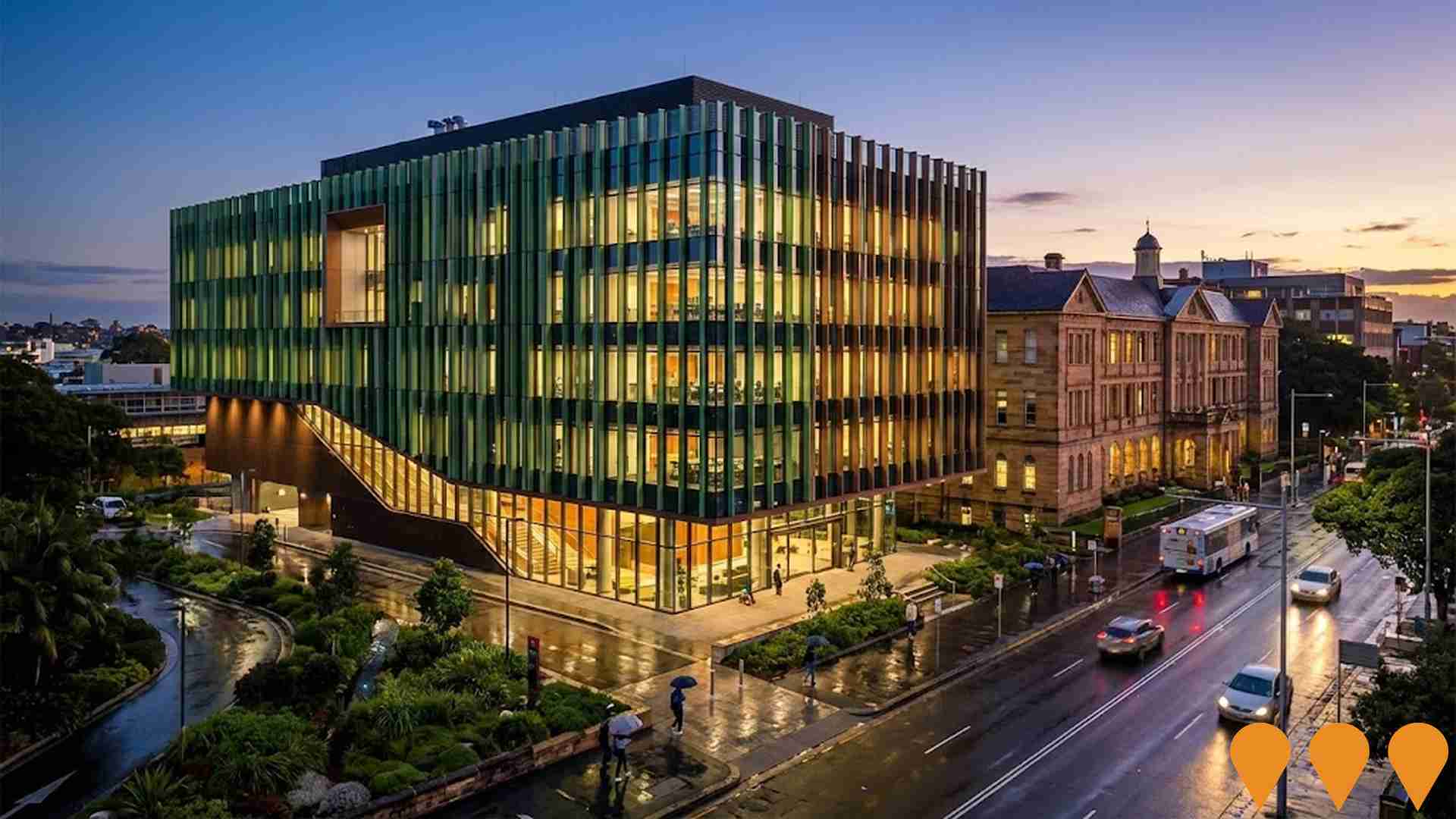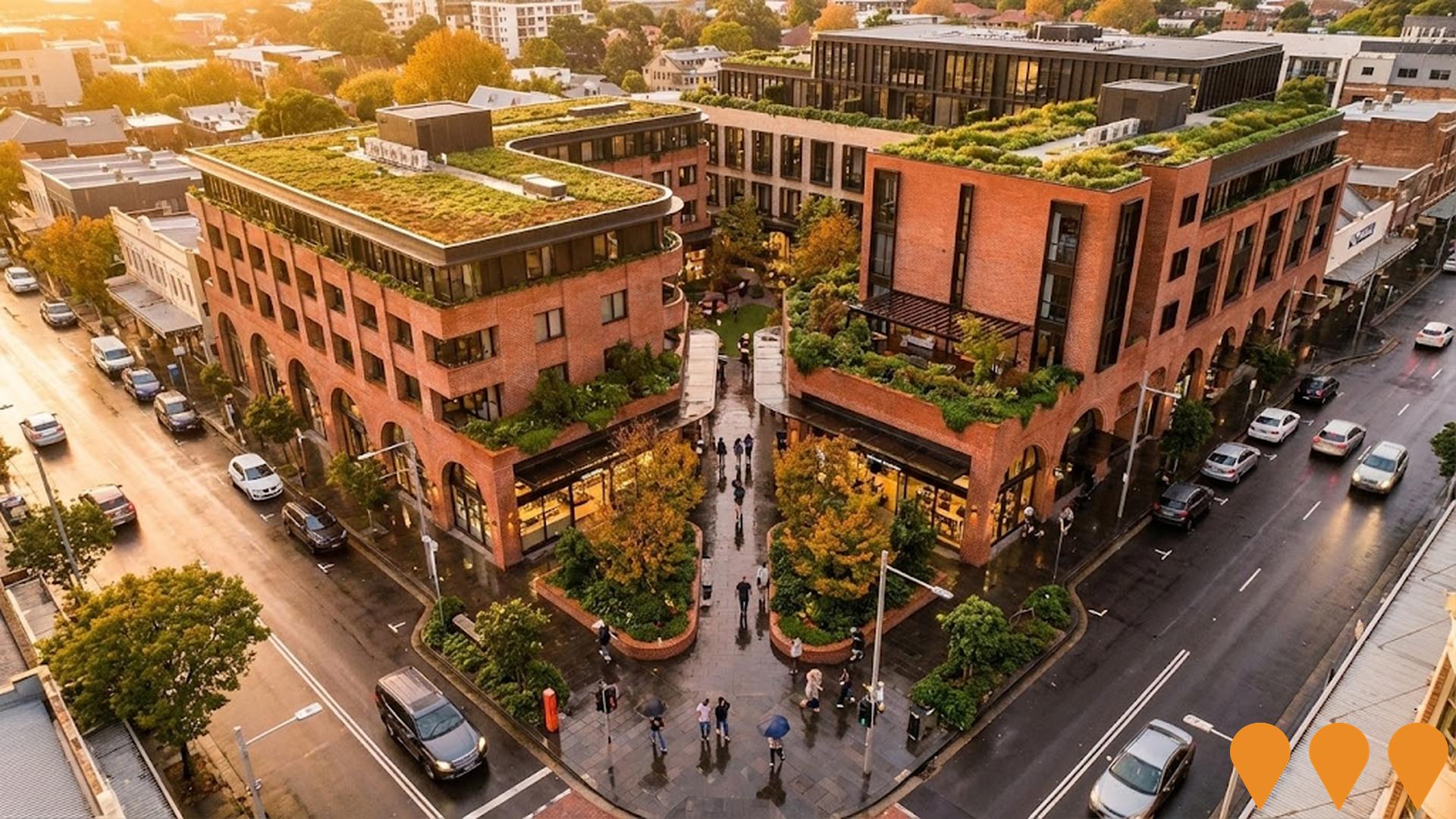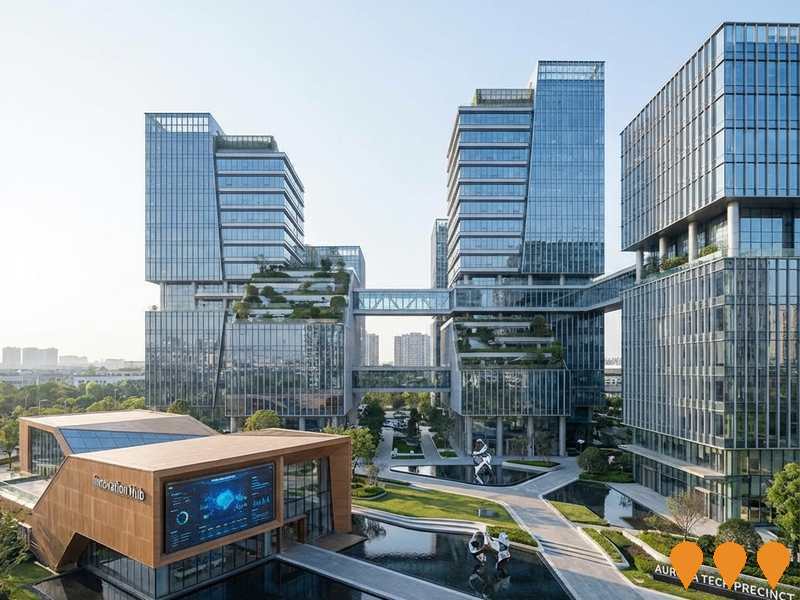Chart Color Schemes
est. as @ -- *
ABS ERP | -- people | --
2021 Census | -- people
Sales Activity
Curious about local property values? Filter the chart to assess the volume and appreciation (including resales) trends and regional comparisons, or scroll to the map below view this information at an individual property level.
Find a Recent Sale
Sales Detail
Population
An assessment of population growth drivers in Redfern reveals an overall ranking slightly below national averages considering recent, and medium term trends
Redfern's population, as of November 2025, is approximately 15,571. This figure represents a growth of 1,901 people since the 2021 Census, which recorded a population of 13,670. The increase is inferred from ABS estimated resident population data of 15,359 in June 2024 and an additional 33 validated new addresses post-Census date. This results in a population density ratio of 9,159 persons per square kilometer, placing Redfern among the top 10% of locations assessed by AreaSearch for land scarcity. The area's growth rate of 13.9% since the Census exceeded both state (6.7%) and metropolitan averages, indicating strong growth leadership. Overseas migration contributed approximately 92.3% to overall population gains during recent periods.
AreaSearch uses ABS/Geoscience Australia projections for each SA2 area released in 2024 with a base year of 2022, and NSW State Government's SA2 level projections for areas not covered by this data, released in 2022 with a base year of 2021. Growth rates by age group from these aggregations are applied to all areas for years 2032 to 2041. Future population trends indicate above median growth, with the area projected to increase by 3,061 persons to 2041 based on latest numbers, resulting in an overall increase of 18.3%.
Frequently Asked Questions - Population
Development
Residential development activity is lower than average in Redfern according to AreaSearch's national comparison of local real estate markets
Redfern has received approximately 4 dwelling approvals per year over the past 5 financial years, totalling 21 homes. No approvals have been recorded so far in FY-26. On average, around 15.5 people move to the area annually for each dwelling built between FY-21 and FY-25. This supply lagging demand results in heightened buyer competition and pricing pressures.
New properties are constructed at an average cost of $100,000, reflecting more affordable housing options. In FY-26, $31.9 million in commercial development approvals have been recorded, indicating high local commercial activity. Compared to Greater Sydney and nationally, Redfern has significantly less development activity, which may reinforce demand for existing dwellings. Recent building activity consists solely of townhouses or apartments, creating affordable entry points for downsizers, investors, and first-home buyers. By 2041, Redfern is projected to grow by 2,849 residents.
At current development rates, housing supply may struggle to match population growth, potentially intensifying buyer competition and supporting price increases.
Frequently Asked Questions - Development
Infrastructure
Redfern has very high levels of nearby infrastructure activity, ranking in the top 10% nationally
Infrastructure changes significantly influence an area's performance. AreaSearch identified 59 projects likely impacting the region. Key initiatives include Redfern Place, Redfern Co-Living Housing, Redfern North Eveleigh Precinct Renewal, and Hudson Vine Mixed Use Redevelopment. The following list details those expected to be most relevant.
Professional plan users can use the search below to filter and access additional projects.
INFRASTRUCTURE SEARCH
 Denotes AI-based impression for illustrative purposes only, not to be taken as definitive under any circumstances. Please follow links and conduct other investigations from the project's source for actual imagery. Developers and project owners wishing us to use original imagery please Contact Us and we will do so.
Denotes AI-based impression for illustrative purposes only, not to be taken as definitive under any circumstances. Please follow links and conduct other investigations from the project's source for actual imagery. Developers and project owners wishing us to use original imagery please Contact Us and we will do so.
Frequently Asked Questions - Infrastructure
Tech Central Innovation Precinct
A 6ha+ innovation district spanning Central Station, South Eveleigh, Camperdown and Haymarket. Designed to be Australia's leading deep-tech and advanced manufacturing hub with over 250,000 sqm of new commercial floor space, 25,000+ new jobs and co-location of universities, startups, scale-ups and global tech firms. Multiple buildings already under construction or completed (e.g. Tech Central Scaleup Hub, Atlassian HQ, Quantum Terminal, UTS Central Stage 2).

Green Square Town Centre
Australia's largest urban renewal project covering 278 hectares in Sydney's south. By 2030 the precinct will deliver over 30,500 new homes for 61,000 residents and 21,000 jobs. Key completed facilities include Green Square Library (2018, Gunyama Park Aquatic Centre2021, Drying Green park and the new town square. Multiple residential and mixed-use buildings are under construction or recently completed by Mirvac, Landcom and private developers. Infrastructure works including new roads, cycleways, stormwater harvesting and public domain continue across the precinct.
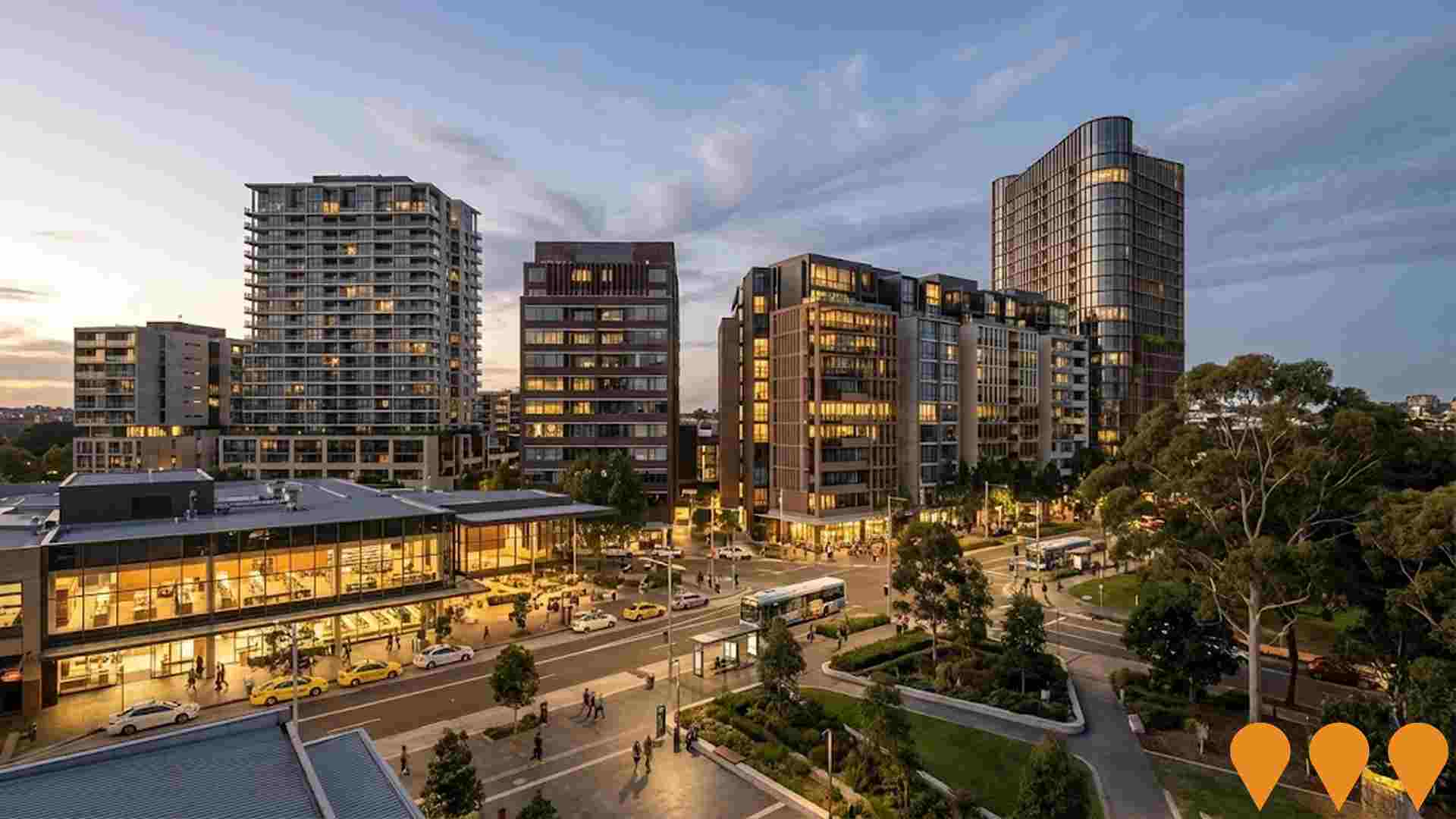
The Erskineville Project (Ashmore Precinct)
Major $2 billion urban renewal masterplan transforming the former Ashmore industrial estate. Features approximately 1,300 Build-to-Rent and Build-to-Sell residences, including the 'Lillian' stage. Includes a new 7,500sqm central park (McPherson Park), 20m wide pedestrian boulevard (Kooka Walk), and 5,000sqm of retail and dining.
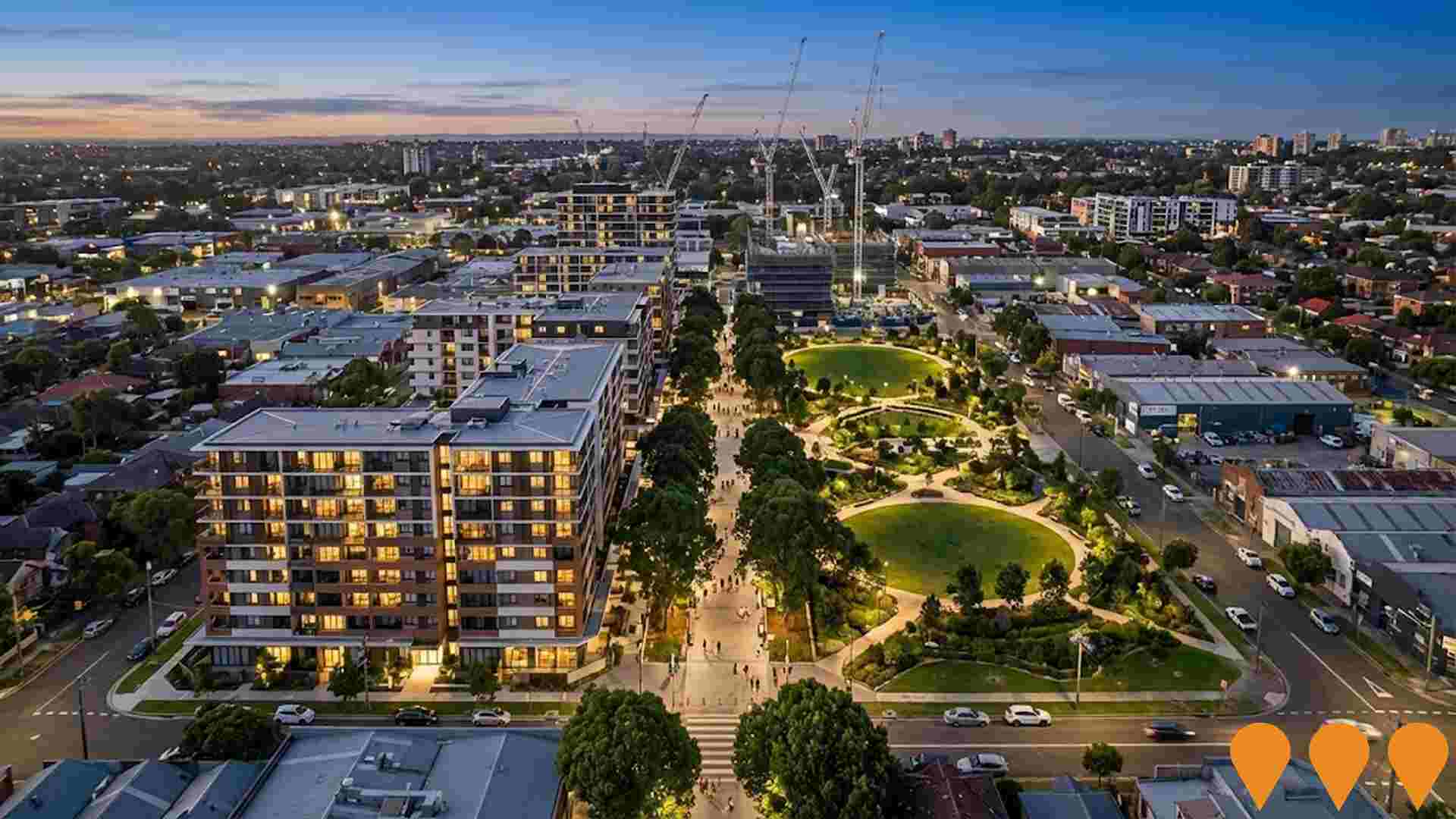
Central Place Sydney
A $3 billion flagship commercial development at the heart of Sydney's 'Tech Central' precinct. The project features two sustainable office towers (35 and 37 storeys) and a low-rise 'connector' building, delivering over 130,000sqm of premium workspace. Designed by SOM and Fender Katsalidis, it aims for 100% renewable energy operations and includes AI-powered closed cavity facades, extensive public realm upgrades, and retail amenities. It will serve as a workplace for over 15,000 employees.
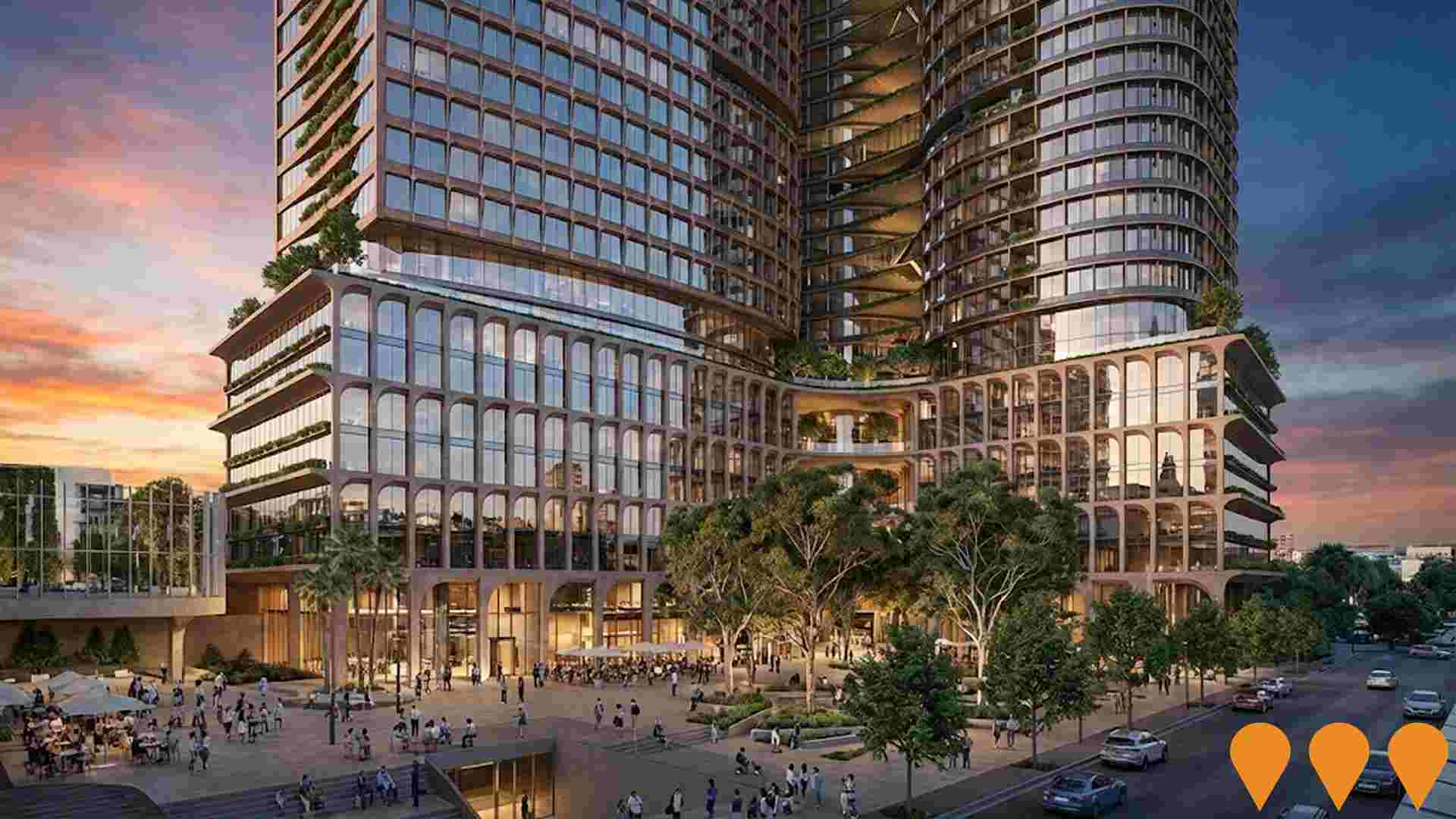
Redfern Place
A $350 million mixed-tenure urban renewal project delivering 355 new homes (147 social housing, 197 affordable housing, 10 disability-support homes and 1 carer's unit), new Bridge Housing headquarters, community hub, replacement PCYC facility, youth hub, ground-floor retail/commercial spaces, communal open space and public domain upgrades. Developed by Bridge Housing in partnership with Capella Capital. SSD application approved in September 2025.
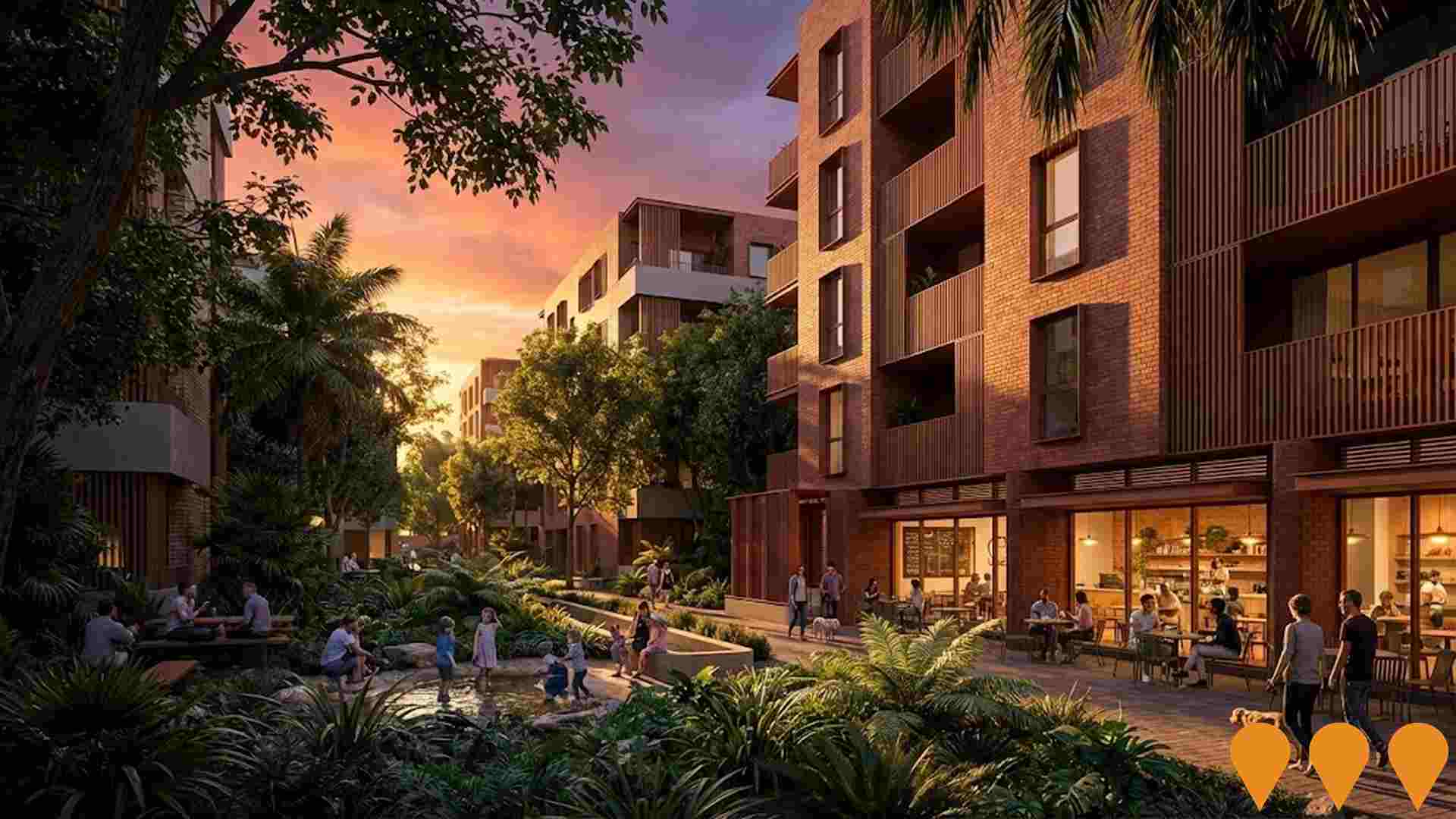
Waterloo Metro Quarter
Major mixed-use over-station precinct development above the new Waterloo Metro Station (Sydney Metro City & Southwest line). Delivered by Mirvac in joint venture with John Holland. Comprises four buildings with approximately 700 residential apartments (including build-to-rent), student accommodation, social and affordable housing (70 social + 5% affordable), retail, commercial office space and significant public domain improvements. Construction commenced 2023, first buildings targeting completion 2026-2027.

Mariyung Fleet (New Intercity Fleet)
The Mariyung Fleet is a 610-carriage double-deck electric train fleet being delivered by RailConnect NSW (UGL, Hyundai Rotem, Mitsubishi Electric Australia) for Transport for NSW. Named after the Darug word for emu, the fleet commenced passenger services on the Central Coast & Newcastle Line on 3 December 2024, followed by the Blue Mountains Line on 13 October 2025. Services on the South Coast Line are scheduled to commence in 2026. The fleet features modern amenities including spacious 2x2 seating, charging ports, improved accessibility with wheelchair spaces and accessible toilets, CCTV emergency help points, and dedicated spaces for luggage, prams and bicycles. The trains operate in flexible 4-car, 6-car, 8-car or 10-car formations. The fleet replaces aging V-set trains that entered service in the 1970s and serves approximately 26 million passenger journeys annually across the electrified intercity network. Supporting infrastructure includes the new Kangy Angy Maintenance Facility, platform extensions, and signaling upgrades at multiple stations.
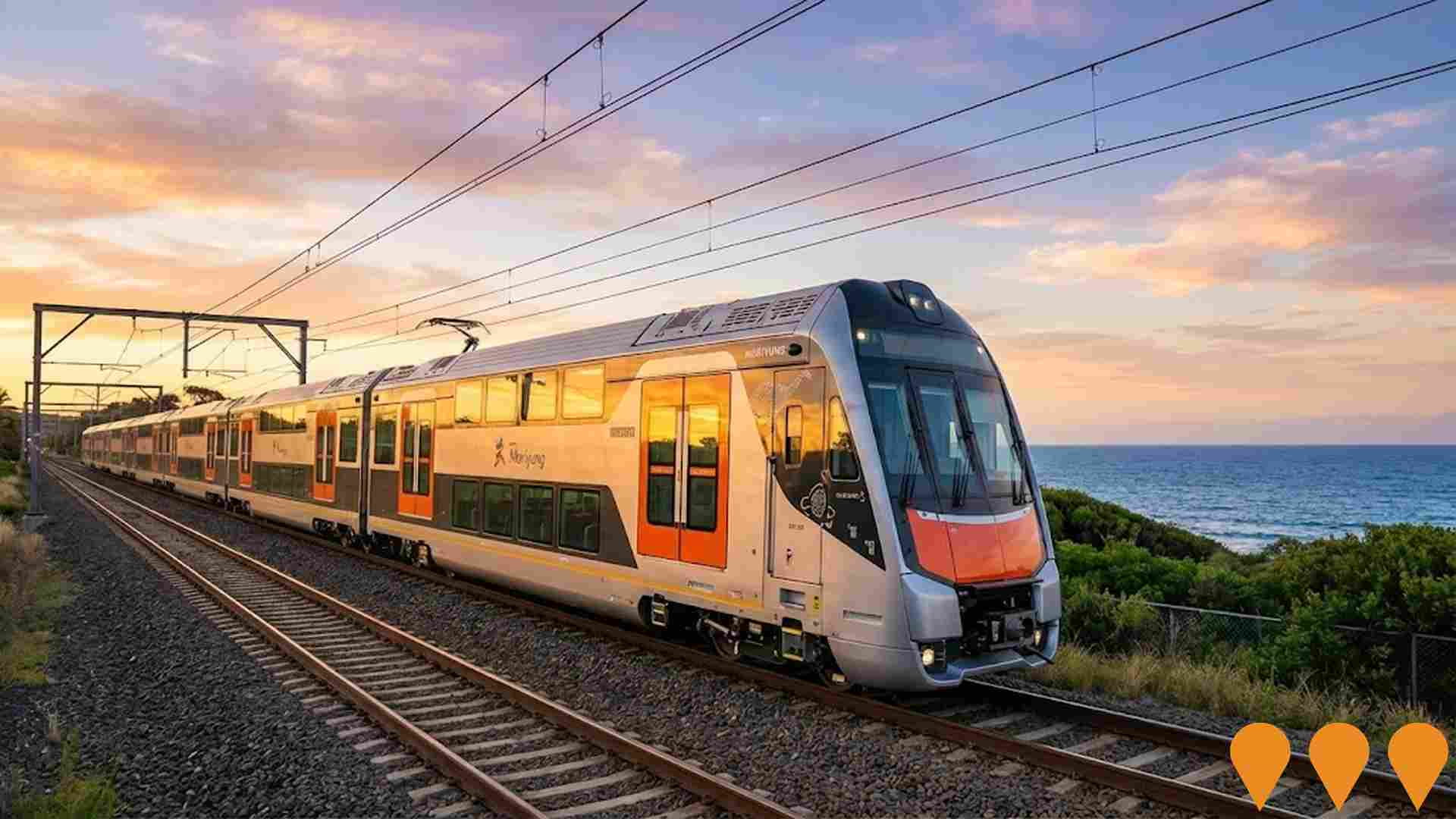
Redfern North Eveleigh Precinct Renewal
A 10-hectare urban renewal project in Redfern, comprising three sub-precincts: Clothing Store, Paint Shop, and Carriageworks. The project includes up to 3,500 new dwellings (minimum 15% affordable housing), commercial and office spaces to support the Tech Central innovation hub, community facilities, and over 3,000sqm of new public spaces, including parks and squares. It features adaptive reuse of heritage railway workshops, such as the Chief Mechanical Engineer's building, and enhanced transport connections. Rezoning and market engagement are ongoing as of 2025.

Employment
AreaSearch assessment indicates Redfern faces employment challenges relative to the majority of Australian markets
Redfern has a highly educated workforce with significant representation in the technology sector. Its unemployment rate was 9.8% as of June 2021.
Employment growth over the past year was estimated at 0.9%. As of June 2025, 9,083 residents are employed, with an unemployment rate of 5.6%, which is higher than Greater Sydney's rate of 4.2%. Workforce participation in Redfern is 65.7%, compared to Greater Sydney's 60.0%. Employment is concentrated in professional & technical, health care & social assistance, and education & training sectors.
The area has a particular specialization in professional & technical jobs, with an employment share of 1.8 times the regional level. Conversely, construction shows lower representation at 4.4% compared to the regional average of 8.6%. There are 1.5 workers for every resident, indicating that Redfern functions as an employment hub attracting workers from surrounding areas. Between June 2024 and June 2025, employment levels increased by 0.9%, while labour force increased by 0.6%, causing the unemployment rate to fall by 0.3 percentage points. In contrast, Greater Sydney experienced employment growth of 2.6% and labour force growth of 2.9%. Jobs and Skills Australia's national employment forecasts from May 2025 suggest that Redfern's employment could grow by approximately 7.4% over five years and 14.7% over ten years, based on a simple weighting extrapolation of industry-specific projections against the local employment mix.
Frequently Asked Questions - Employment
Income
Income metrics indicate excellent economic conditions, with the area achieving higher performance than 75% of national locations assessed by AreaSearch
Redfern's median income among taxpayers was $68,489 and average income stood at $96,484 during financial year 2022. This compares to Greater Sydney's figures of $56,994 and $80,856 respectively. According to the Wage Price Index growth of 12.61% since financial year 2022, current estimates for Redfern would be approximately $77,125 (median) and $108,651 (average) as of September 2025. Individual earnings in Redfern stand out at the 90th percentile nationally, with a figure of $1,178 weekly. In terms of income distribution, 24.9% of Redfern's population falls within the $1,500 - $2,999 income range, consisting of 3,877 individuals. This is consistent with broader trends across regional levels showing 30.9% in the same category. Notably, 36.5% of Redfern's population earns above $3,000 weekly, indicating strong economic capacity throughout the area. High housing costs consume 21.6% of income, but despite this, disposable income places Redfern at the 64th percentile nationally. The area's SEIFA income ranking places it in the 8th decile.
Frequently Asked Questions - Income
Housing
Redfern features a more urban dwelling mix with significant apartment living, with above-average rates of outright home ownership
The dwelling structure in Redfern, as per the latest Census, consisted of 1.4% houses and 98.6% other dwellings (semi-detached, apartments, 'other' dwellings). In comparison, Sydney metro had 2.3% houses and 97.7% other dwellings. Home ownership in Redfern was at 14.7%, similar to Sydney metro's rate. The remaining dwellings were either mortgaged (21.0%) or rented (64.3%). The median monthly mortgage repayment in the area was $2,789, higher than Sydney metro's average of $2,705. The median weekly rent figure for Redfern was $500, compared to Sydney metro's $550. Nationally, Redfern's mortgage repayments were significantly higher than the Australian average of $1,863, while rents were substantially above the national figure of $375.
Frequently Asked Questions - Housing
Household Composition
Redfern features high concentrations of group households and lone person households, with a fairly typical median household size
Family households account for 45.3% of all households, including 11.6% that are couples with children, 27.2% that are couples without children, and 5.2% that are single parent families. Non-family households make up the remaining 54.7%, with lone person households at 42.1% and group households comprising 12.6%. The median household size is 1.9 people, which matches the Greater Sydney average.
Frequently Asked Questions - Households
Local Schools & Education
Educational outcomes in Redfern fall within the lower quartile nationally, indicating opportunities for improvement in qualification attainment
Educational attainment in Redfern is notably high, with 56.5% of residents aged 15 years and above possessing university qualifications. This figure exceeds the national average of 30.4% and the NSW state average of 32.2%. The most common qualification held by residents is a Bachelor degree at 36.7%, followed by postgraduate qualifications (16.4%) and graduate diplomas (3.4%). Vocational pathways account for 20.0% of qualifications, with advanced diplomas making up 9.8% and certificates comprising 10.2%.
Educational participation is high in Redfern, with 28.8% of residents currently enrolled in formal education. This includes 12.3% in tertiary education, 4.6% in primary education, and 3.0% pursuing secondary education. The three schools in Redfern have a combined enrollment reaching 95 students. Educational provision is conventional, with one primary institution and one secondary institution serving the area. Additionally, there is a specialist school addressing specific learning needs. Local school capacity is limited at 0.6 places per 100 residents compared to the regional average of 7.7, leading many families to travel outside the area for schooling.
Frequently Asked Questions - Education
Schools Detail
Nearby Services & Amenities
Transport
Transport servicing is high compared to other areas nationally based on assessment of service frequency, route connectivity and accessibility
Transport analysis reveals 43 active transport stops operating within Redfern. These comprise a mix of train and bus services. They are serviced by 30 individual routes.
Collectively, these provide 22,909 weekly passenger trips. Transport accessibility is rated as excellent in Redfern, with residents typically located 129 meters from the nearest transport stop. Service frequency averages 3,272 trips per day across all routes, equating to approximately 532 weekly trips per individual stop.
Frequently Asked Questions - Transport
Transport Stops Detail
Health
Redfern's residents are healthier than average in comparison to broader Australia with prevalence of common health conditions quite low among the general population though higher than the nation's average across older, at risk cohorts
Health data shows relatively positive outcomes for Redfern residents. Prevalence of common health conditions is quite low among the general population but higher than the national average among older, at-risk cohorts.
Approximately 70% of the total population (10,868 people) has private health cover, compared to the national average of 55.3%. The most common medical conditions in the area are mental health issues and asthma, affecting 11.0% and 7.4% of residents respectively. 70.5% of residents declare themselves completely clear of medical ailments, compared to 77.4% across Greater Sydney. Redfern has 13.6% of residents aged 65 and over (2,122 people), which is higher than the 9.7% in Greater Sydney.
Frequently Asked Questions - Health
Cultural Diversity
Redfern is among the most culturally diverse areas in the country based on AreaSearch assessment of a range of language and cultural background related metrics
Redfern has notable cultural diversity, with 29.4% of its population speaking a language other than English at home and 43.5% born overseas. The predominant religion in Redfern is Christianity, comprising 30.3% of the population. However, Judaism is overrepresented in Redfern compared to Greater Sydney, making up 1.6% versus 1.1%.
In terms of ancestry, the top three groups are English (21.7%), Australian (15.7%), and Other (14.2%). Some ethnic groups show notable differences: French at 1.4% in Redfern compared to 1.1% regionally, Spanish at 1.1% versus 1.0%, and Russian at 0.9% versus 0.8%.
Frequently Asked Questions - Diversity
Age
Redfern's population is slightly younger than the national pattern
Redfern's median age is 36 years, nearly matching Greater Sydney's average of 37, which is modestly under the Australian median of 38. Compared to Greater Sydney, Redfern has a higher concentration of residents aged 25-34 (26.5%) but fewer residents aged 5-14 (5.1%). This 25-34 concentration is well above the national average of 14.5%. According to the 2021 Census, the population aged 15 to 24 grew from 10.3% to 13.2%, while the 35 to 44 cohort declined from 17.5% to 16.5%. Demographic modeling suggests that Redfern's age profile will significantly change by 2041. The 25 to 34 age group is projected to grow strongly at 85%, adding 3,517 residents to reach a total of 7,650. In contrast, both the 0 to 4 and 5 to 14 age groups are expected to have reduced numbers.

